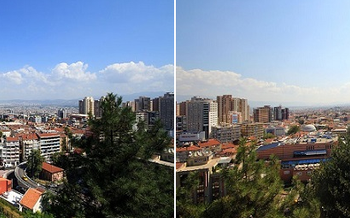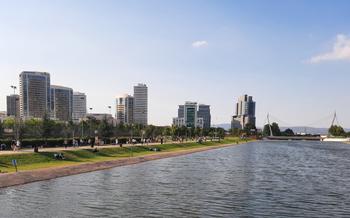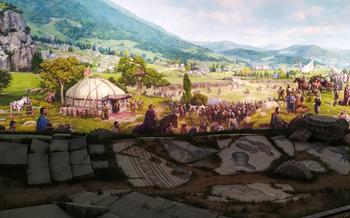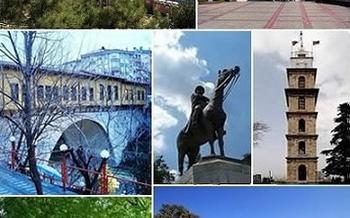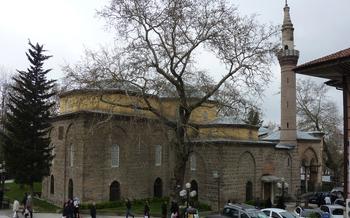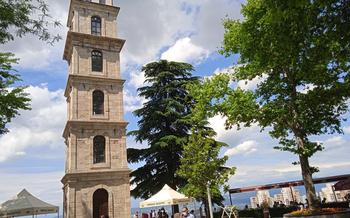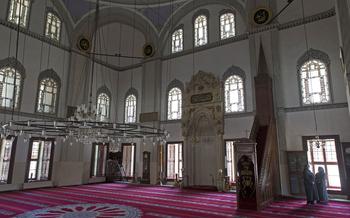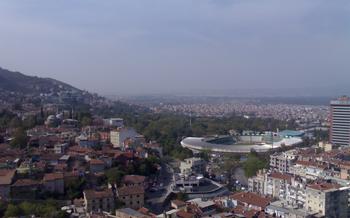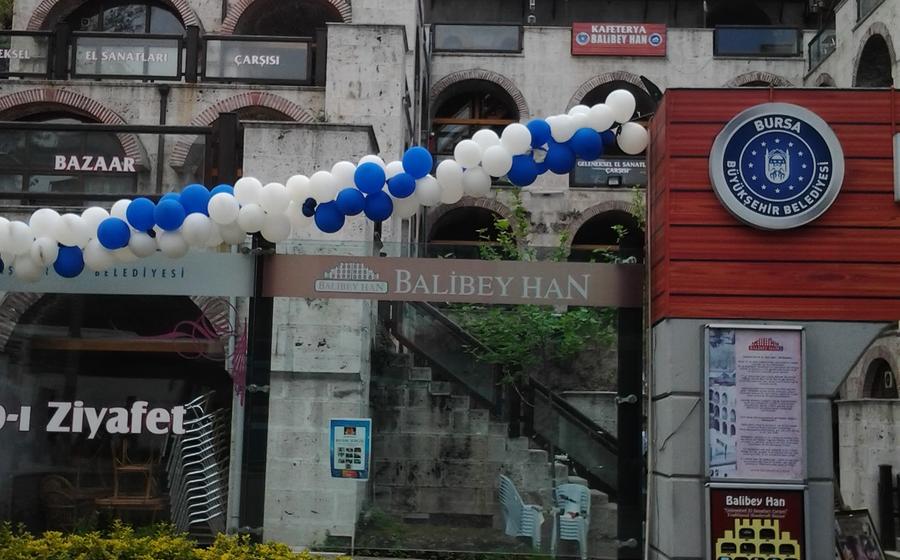
Black Church (Kara Kilise)
- Historical Significance
- Location and Accessibility
- Visiting Hours and Admission
- Architectural Features
- Religious Significance
- Historical Events and Personalities
- Preservation and Restoration Efforts
- Cultural Significance
- Nearby Attractions
- Photography and Social Media
- Local Customs and Etiquette
- Accessibility for Travelers with Disabilities
- Local Cuisine and Restaurants
- Insider Tip
Historical Significance
The Black Church, also known as the Church of the Dormition of the Virgin Mary, stands as a testament to Bursa's rich history and diverse cultural heritage. Built in the 14th century during the reign of the Ottoman Empire, it is considered one of the oldest churches in Bursa and one of the few remaining examples of Byzantine architecture in the region. The church holds immense religious significance as a symbol of the Christian faith, and its unique architectural style and historical anecdotes make it a must-visit destination for anyone interested in exploring the diverse religious and cultural tapestry of Bursa.
Location and Accessibility
The Black Church is situated in the heart of Bursa, a city in northwestern Turkey, renowned for its rich history and cultural heritage. Its exact location is at the intersection of Atatürk Caddesi and Yeşil Caddesi in the Tophane neighborhood. Visitors can easily reach the church by various means of transportation.
Public transportation is a convenient option, with multiple bus lines stopping nearby. The Tram line also has a stop within walking distance, making it accessible from different parts of the city. For those arriving by car, there are limited parking spaces available on the surrounding streets. However, it's important to note that parking restrictions may apply, and it's advisable to check the signage carefully.
The Black Church is wheelchair accessible, with ramps leading to the entrance. Inside, the church's wide aisles and open spaces allow for easy movement for visitors with disabilities. Visitors should feel comfortable approaching the church staff or volunteers for assistance if needed.
Visiting Hours and Admission
The Black Church in Bursa welcomes visitors with open arms, offering them the opportunity to explore its historical and religious significance. The church's doors are open daily from 9:00 AM to 5:00 PM, inviting travelers to step back in time and immerse themselves in its captivating atmosphere.
Admission to the church is free of charge, allowing everyone to experience its beauty and tranquility without any financial barriers. However, donations are gratefully accepted to support the ongoing preservation and restoration efforts.
Guided tours are available in various languages, including English, Turkish, and French, providing visitors with a deeper understanding of the church's history, architecture, and religious significance. These tours are led by knowledgeable guides who share fascinating insights and stories, bringing the church's past to life. To book a guided tour, visitors can contact the church office in advance or inquire upon arrival.
For a more serene and immersive experience, it is recommended to visit the church during the weekdays, as weekends tend to be busier with local worshippers and tourists. Whether you choose to explore the church independently or with a guide, the Black Church offers a truly enriching experience that will leave a lasting impression.
Architectural Features
The Black Church stands as a testament to the Gothic architectural style that flourished in Europe during the Middle Ages. Its exterior is characterized by intricate stone carvings, pointed arches, and flying buttresses that lend a sense of grandeur and lightness to the structure. The facade is adorned with beautiful rose windows and sculptures depicting biblical scenes and figures.
Inside, the church boasts a spacious nave with tall, ribbed vaults that create a sense of awe and reverence. The apse is decorated with stunning stained glass windows that depict religious scenes and fill the interior with vibrant colors. The intricately carved pulpit and altar are focal points of the church, showcasing the skill and artistry of the craftsmen who created them.
Unique architectural elements such as gargoyles and a bell tower add to the charm and character of the Black Church. The gargoyles, with their grotesque and whimsical expressions, serve as water spouts, diverting rainwater away from the building. The bell tower, with its pointed spire, rises above the church and offers panoramic views of Bursa and the surrounding landscape.
In comparison to other similar churches in the region, the Black Church stands out for its well-preserved state and its unique blend of architectural styles. It is considered one of the finest examples of Gothic architecture in Turkey and continues to inspire awe and admiration in visitors from around the world.
Religious Significance
The Black Church stands as a testament to the deep-rooted Christian faith in Bursa and serves as a sacred place of worship for the local Christian community. Its religious significance extends beyond its physical structure, embodying the spiritual essence of a place dedicated to prayer, contemplation, and the celebration of religious ceremonies.
Throughout the year, the Black Church hosts regular masses, services, and special events that bring together believers from all walks of life. These gatherings foster a sense of unity, faith, and devotion among the congregation, reinforcing the church's role as a spiritual center for the Christian community.
The Black Church is adorned with rich symbolism and iconography that speak to its religious significance. From the intricately carved Stations of the Cross to the stained glass windows depicting biblical scenes, every element within the church holds spiritual meaning and contributes to its sacred atmosphere.
Stories of faith, devotion, and miracles are deeply intertwined with the history of the Black Church. Believers often share tales of answered prayers, spiritual encounters, and divine interventions that have taken place within its walls, further solidifying its reputation as a place of spiritual power and grace.
Historical Events and Personalities
The Black Church has witnessed numerous significant historical events and been associated with notable figures throughout its existence. In the 14th century, it served as a temporary resting place for the body of Orhan Gazi, the founder of the Ottoman Empire, before his final burial in Bursa. This event underscores the church's importance as a revered site for both Christians and Muslims in the region.
During the Ottoman era, the church underwent several transformations and renovations. In the 16th century, Sultan Suleiman the Magnificent granted permission for the church to be repaired and restored, demonstrating the sultan's commitment to religious tolerance and the preservation of cultural heritage. This act of benevolence allowed the church to continue serving as a place of worship for the Christian community in Bursa.
The Black Church also played a role during the Turkish War of Independence. In 1922, as the Turkish army approached Bursa, the church provided refuge for both Turkish and Christian civilians seeking shelter from the conflict. This act of compassion and unity amidst a tumultuous period highlights the church's significance as a symbol of peace and coexistence.
Throughout its history, the Black Church has been associated with notable figures from different walks of life. One such figure is Evliya Çelebi, a renowned Ottoman traveler and writer. In his travelogue, Çelebi described the church as one of the most impressive buildings in Bursa, praising its architectural beauty and historical significance. His writings have contributed to the church's fame and recognition as a cultural landmark.
Preservation and Restoration Efforts
The Black Church has undergone several restoration and preservation efforts throughout its history to maintain its architectural integrity and historical significance. In the early 20th century, the church underwent extensive renovations to repair damage caused by earthquakes and neglect. These efforts included strengthening the structure, restoring the stonework, and repairing the stained glass windows.
In recent years, the Black Church has benefited from ongoing preservation initiatives led by local authorities and cultural organizations. These projects have focused on preserving the church's unique architectural features, such as its Gothic vaulting and intricate carvings. The restoration work has also involved cleaning and conserving the church's interior, including its frescoes and iconography.
Preserving the Black Church is crucial for several reasons. First, it is a valuable example of Gothic architecture and a testament to the region's rich cultural heritage. Moreover, the church holds religious significance for the Christian community in Bursa and is a symbol of tolerance and diversity. By preserving the Black Church, we ensure that future generations can continue to appreciate its beauty, historical importance, and spiritual significance.
Cultural Significance
The Black Church stands as a symbol of cultural diversity and religious tolerance in Bursa. Its existence bears witness to the city's rich history of peaceful coexistence among different faiths. The church has played a crucial role in fostering understanding and dialogue between Christians and Muslims, promoting mutual respect and cooperation.
Over the centuries, the Black Church has become an integral part of Bursa's cultural heritage. Its unique architecture, historical significance, and spiritual essence have made it a beloved landmark for people of all backgrounds. The church serves as a reminder of the city's commitment to preserving its diverse cultural heritage and promoting religious harmony.
To further enhance cultural exchange and understanding, the Black Church often hosts events and initiatives that bring together people from different faiths and backgrounds. These events may include interfaith dialogues, cultural exhibitions, and music concerts, creating a platform for people to share their beliefs, traditions, and experiences.
By embracing its cultural diversity and promoting religious tolerance, Bursa sets an example of how different faiths can coexist peacefully and contribute to the richness and vibrancy of a community. The Black Church stands as a testament to this spirit of unity and understanding, inspiring visitors from around the world.
Nearby Attractions
A visit to the Black Church can be easily combined with other attractions in Bursa. The city is home to several historical sites, museums, and landmarks that offer a glimpse into its rich past and vibrant culture.
Just a short walk from the Black Church is the Bursa Ulu Cami, or Grand Mosque. This impressive 14th-century mosque is one of the largest in Turkey and features a stunning dome, intricate tilework, and a beautiful courtyard.
For those interested in history, the Bursa Archeological Museum houses a collection of artifacts from the city's ancient past, including the Hellenistic, Roman, and Byzantine periods. The museum provides a fascinating insight into the region's rich history and cultural heritage.
Another popular attraction is the Koza Han, a 15th-century caravanserai that has been restored and now houses shops, cafes, and restaurants. This bustling marketplace offers a glimpse into Bursa's traditional trade and commerce, and is a great place to find souvenirs or enjoy a traditional Turkish meal.
For those looking to immerse themselves in nature, Bursa is surrounded by beautiful parks and gardens. The nearby Uludag National Park offers stunning mountain scenery, hiking trails, and winter sports facilities.
To make the most of your visit, consider taking a guided tour of Bursa. These tours typically cover the city's main attractions, including the Black Church, and provide valuable insights into their history and significance.
Photography and Social Media
The Black Church offers ample opportunities for photography enthusiasts to capture stunning images of its architectural grandeur and intricate details. The Gothic exterior, with its weathered stonework and intricate carvings, provides a picturesque backdrop for photographs. Inside the church, the stained glass windows cast a beautiful play of light, creating a magical atmosphere for capturing interior shots.
When photographing the church, be sure to explore different angles and perspectives to capture its unique features. Experiment with different lighting conditions, such as early morning or golden hour, to create dramatic and captivating images.
For those who love sharing their travel experiences on social media, the Black Church is an Instagrammable spot not to be missed. Don't forget to use relevant hashtags like #BlackChurch, #Bursa, and #Turkey to connect with other travelers and share your photos with the world.
While capturing the beauty of the church through photography, it's important to be respectful and mindful of the religious significance of the site. Avoid using flash photography during services or ceremonies, and always ask permission before taking photos of people or sensitive areas.
Local Customs and Etiquette
When visiting the Black Church, it is essential to be mindful of local customs and etiquette to show respect for the religious significance of the site. Visitors should dress modestly and avoid wearing revealing or inappropriate clothing. Shorts, tank tops, and excessively tight clothing are generally not considered appropriate attire for entering a religious building. It is customary to remove shoes before entering the mosque, and visitors should follow this practice to maintain cleanliness and respect the sacred space.
When inside the church, visitors should be mindful of ongoing religious services or ceremonies. It is important to remain silent and avoid disturbing worshippers. Photography is generally permitted, but visitors should ask permission before taking photos of people or sensitive areas. It is also essential to be respectful of the religious beliefs and practices of others and to avoid engaging in any behavior that could be considered offensive or disrespectful.
By observing local customs and etiquette, visitors can contribute to preserving the sanctity of the Black Church and ensure a positive and respectful experience for all.
Accessibility for Travelers with Disabilities
The Black Church is committed to ensuring that all visitors have a welcoming and accessible experience. The church features several accessibility features to accommodate travelers with disabilities or special needs. Wheelchair-accessible ramps and elevators provide easy access to different parts of the church, including the nave, apse, and choir loft. Visitors with visual impairments can request audio guides or tactile maps to assist them in navigating the church and learning about its history and architecture. Additionally, the church offers sign language interpretation services for visitors who are hearing-impaired.
For a more personalized experience, visitors with disabilities can contact the church in advance to arrange for specific assistance or accommodations. The church staff is dedicated to providing support and ensuring that everyone has an enriching and enjoyable visit to the Black Church.
Local Cuisine and Restaurants
After exploring the Black Church, take a break and savor the delicious local cuisine at one of the many restaurants or cafes nearby. Indulge in traditional Turkish dishes such as kebabs, gözleme (savory pancakes), or pide (Turkish pizza). For a taste of Bursa's specialty, try iskender kebap, a dish of thinly sliced doner kebab topped with tomato sauce, yogurt, and melted butter. Several restaurants in the area cater to a variety of dietary preferences, including halal and vegetarian options. Enjoy a leisurely meal or a refreshing drink while immersing yourself in the vibrant atmosphere of Bursa.
Insider Tip
One of the most captivating features of the Black Church is its hidden garden. Tucked away behind the main altar, this serene oasis offers a tranquil escape from the bustling city. Visitors can wander through the lush greenery, admire the colorful flowers, and find a moment of peace and reflection. Take a break from exploring the church's interior and step into this hidden gem for a unique and peaceful experience.
